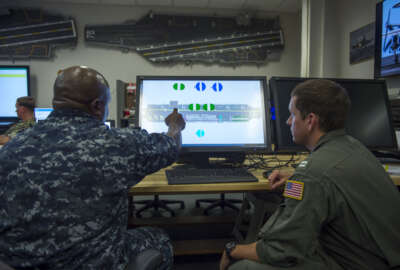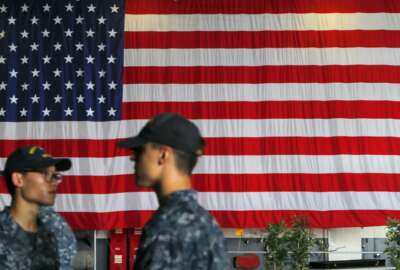
Navy unveils plan to trim fat and align with defense strategy
The Navy will work on streamlining everything from readiness to personnel.
Best listening experience is on Chrome, Firefox or Safari. Subscribe to Federal Drive’s daily audio interviews on Apple Podcasts or PodcastOne.
The Department of the Navy is transforming everything it does. From modernization to readiness, and from personnel to business structure, the Navy is trying to trim down and align itself with Defense Secretary Jim Mattis’ National Defense Strategy.

That 66-page strategy lays out specific plans and timelines for sections of the Navy to improve business processes, better the Department of the Navy’s information infrastructure and even improve relations with allies.
“We’ve done one of these plans before,” said Navy Undersecretary Thomas Modly in a Wednesday call with reporters. “This is the first time we’ve tied it to broad strategy. The National Defense Strategy gave us a broad framework to work from.”
Those objectives are based on three main tenets:
- Build a more lethal force
- Strengthen alliances and attract new partners
- Reform the department for greater performance
The defense strategy is meant to prepare the military for competitors like China and Russia.
“We went out and asked the entire Department of the Navy in the business mission area to look at what they were doing to support those various elements of the strategy, and to determine more specifically how they are driving toward change in those areas that support the objectives of the defense strategy,” Modly said.
One of the most important parts of the strategy, Modly said, is that the objectives will be tied to six month timelines going out to two years from now.
At each six month interval, the Department of the Navy plans to look at its progress and publish a new strategy that is updated and adds on new objectives as they change.
The Navy is currently working on a plan for how it will actually measure its progress within those intervals.
While some of the solutions are easily measured like “publish a Marine Corps cloud strategy,” others are much more amorphous like “initiate new Department of Navy programs with confidence.”
“That’s the next phase of this. The first quarter of this is taking a look at this plan and defining i.” Modly said. “(Asking) what are we going to improve it to and how do we measure that? What is the true goal? Does it really make sense to improve that? Should we be thinking about this particular line of effort in a different way? This is sort of putting a stake in the ground and then improving the plan over time.”
The plan is detailed and breaks each defense strategy into sections. It also breaks down milestones individually for the Marine Corps, the Navy and the Secretariat.
To build a more lethal force the Navy plans to fully restore aviation, ship and personnel readiness. It also wants to develop and implement a sustainable path to infrastructure modernization.
For example, the plan states the Marine Corps has numerous aging facilities that require significant funding to restore or modernize.
The plan suggests creating a “right-size” strategy that eliminates the worst facilities by 2022. It also states the Marine Corps will standardize its base facility requirements.
As for the milestones to complete those objectives, the Marine Corps will be required to report its progress on eliminating the worst facilities by mid-2019 and to standardize requirements by the end of 2019.
“I’m going to be very, very involved in the execution and monitoring of this plan,” Modly said. “I’m looking for us to hit our milestones and also for adding new initiatives to it and for abandoning initiatives that don’t make sense in the context of our strategy. This is a role for the chief management officer of the Navy, is to manage this plan and be accountable for it.”
Modly said some of initiatives are already underway. That includes improving financial systems and consolidating ledgers.
Other programs already underway have to do with personnel.
“If you look at some of the human capital reform modernization for how we manage sailors and their careers, that started a year or so ago, it’s being implemented and it’s included in the plan as well,” Modly said.
Congress called on all the military services to create a business operations plan. Modly said he does not expect the plan will cost the Navy any extra money and hopes it will free up some funds with the efficiencies it creates.
Modly did not have an estimate for how much the Navy might save.
Copyright © 2025 Federal News Network. All rights reserved. This website is not intended for users located within the European Economic Area.
Scott Maucione is a defense reporter for Federal News Network and reports on human capital, workforce and the Defense Department at-large.
Follow @smaucioneWFED





